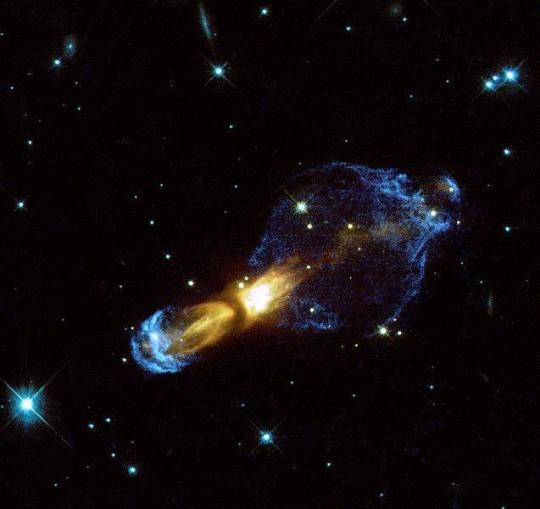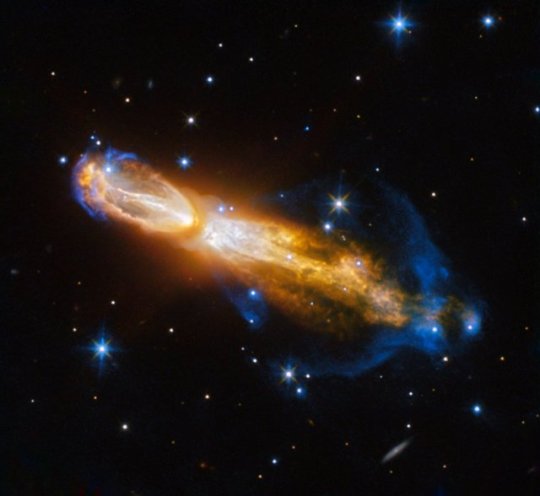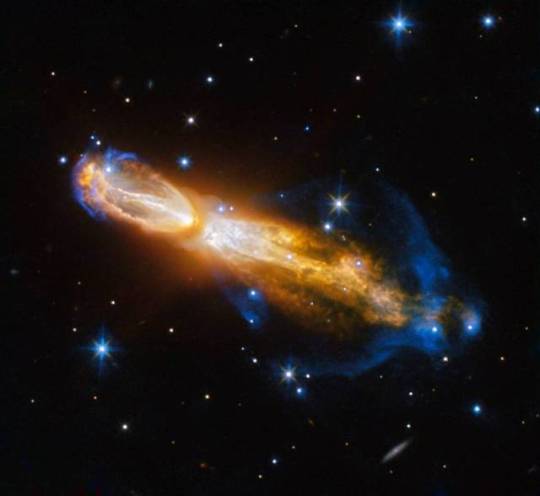#rotten egg nebula
Text

Collisions in Dying Star: Rotten Egg Nebula ©
#nebula#rotten egg nebula#space#astrophotography#nasa#stars#night sky#solar system#astronomy#galaxy#planet#universe#cosmos
906 notes
·
View notes
Photo

The Rotten Egg Planetary Nebula
Credits: Caltech, ESA, NASA
20 notes
·
View notes
Note
I have a proposition AU. Coraline gets the butterfly miraculous and Wybie has the Peacock miraculous and they use it to get revenge
Actually, the Red Blitz he’s talking about is Coraline, but… MaleWife!Wybie and GirlBoss!Coraline make me happy!
Coraline is Nebula (There’s a “Butterfly Nebula” and the space thing makes me think of her star sweater. Got it? Okay.)
Nebula: Let’s get revenge on Brittany Wheeler and her army of skanks!
Obsidian Plume: No.
Nebula: But-
Obsidian Plume: No.
Nebula: How about just-
Obsidian Plume: Jonesy. No.
Nebula: Please?
Obsidian Plume: … Okay.
Coraline Akumatizes other Laika kids (Norman, Neil, Eggs, Winnie, Kubo, Kat, and Raúl. 5 Points to whoever knows what movies they’re from)
Wybie is a total mom to his Sentimonsters. He will spoil them rotten, and Coraline has to keep him from spending $500 on stuff for them
Anyway, they decide to give themselves from free therapy for their childhood traumas by sending Sentimonsters through the door to torment the Beldam
Coraline: Oh! Let’s send Cat’s Eye next!
Wybie: I’m not sending a baby after that maniac!
Coraline: They’re all barely a year old, they’re all babies.
Wybie: *Holds up Cat’s Eye* You look this baby in the eye and tell him he’s going harass a button-crazed maniac.
Coraline: … You’re gonna harass-
Wybie: Jonesy!
Nebula’s in a fancy-ass suit with slick-back hair because she’s a girl boss
If Nebula gets hurt, which is rare, Obsidian Plume’s fancy jacket comes off, and he will throw hands
So many headaches from having to sense people’s emotions
They take turns evilly stroking the cat
#miraculous ladybug#miraculous#Coraline#Coraline Jones#Wybie Lovat#butterfly miraculous#peacock miraculous#answered ask#ask me stuff#mlb au
17 notes
·
View notes
Text
“Do you remember how the night sky of Ischia horrified me? You all said how beautiful it is, but I couldn’t. I smelled an odor of rotten eggs, eggs with a greenish-yellow yolk inside the white and inside the shell, a hard-boiled egg cracked open. I had in my mouth poisoned egg stars, their light had a white, gummy consistency, it stuck to your teeth, along with the gelatinous black of the sky, I crushed it with disgust, I tasted a crackling of grit. Am I clear? Am I making myself clear? And yet on Ischia I was happy, full of love. But it was no use, my head always finds a chink to peer through, beyond—above, beneath, on the side—where the fear is. In Bruno’s factory, for example, the bones of the animals cracked in your fingers if you merely touched them, and a rancid marrow spilled out. I was so afraid that I thought I was sick. But was I sick? Did I really have a murmur in my heart? No. The only problem has always been the disquiet of my mind. I can’t stop it, I always have to do, redo, cover, uncover, reinforce, and then suddenly undo, break. Take Alfonso, he’s always made me nervous, ever since he was a boy, I’ve felt that the cotton thread that held him together was about to break. And Michele? Michele thought he was who knows what, and yet all I had to do was find his boundary line and pull, oh, oh, oh, I broke it, I broke his cotton thread and tangled it with Alfonso’s, male material inside male material, the fabric that I weave by day is unraveled by night, the head finds a way. But it’s not much use, the terror remains, it’s always in the crack between one normal thing and the other. It’s there waiting, I’ve always suspected it, and since yesterday evening I’ve known for certain: nothing lasts, Lenù, even here in my belly, you think the creature will endure but it won’t. You remember when I married Stefano and I wanted the neighborhood to start again from the beginning, to be only beautiful things, the ugliness of before was not supposed to be there anymore. How long did it last? Good feelings are fragile, with me love doesn’t last. Love for a man doesn’t last, not even love for a child, it soon gets a hole in it. You look in the hole and you see the nebula of good intentions mixed up with the nebula of bad. Gennaro makes me feel guilty, this thing here in my belly is a responsibility that cuts me, scratches me. Loving courses together with hating, and I can’t, I can’t manage to solidify myself around any goodwill. Maestra Oliviero was right, I’m bad. I don’t even know how to keep friendship alive. You’re kind, Lenù, you’ve always had a lot of patience. But tonight I finally understood it: there is always a solvent that acts slowly, with a gentle heat, and undoes everything, even when there’s no earthquake. So please, if I insult you, if I say ugly things to you, stop up your ears, I don’t want to do it and yet I do. Please, please, don’t leave me, or I’ll fall in.”
Elena Ferrante - The Story of the Lost Child
106 notes
·
View notes
Text

Calabash "Rotten Egg" Nebula
"The Calabash Nebula, pictured here — which has the technical name OH 231.8+04.2 — is a spectacular example of the death of a low-mass star like the sun. This image taken by the NASA/ESA Hubble Space Telescope shows the star going through a rapid transformation from a red giant to a planetary nebula, during which it blows its outer layers of gas and dust out into the surrounding space. The recently ejected material is spat out in opposite directions with immense speed — the gas shown in yellow is moving close to one million kilometers per hour (621,371 miles per hour). Astronomers rarely capture a star in this phase of its evolution because it occurs within the blink of an eye — in astronomical terms. Over the next thousand years the nebula is expected to evolve into a fully-fledged planetary nebula. The nebula is also known as the Rotten Egg Nebula because it contains a lot of sulphur, an element that, when combined with other elements, smells like a rotten egg — but luckily, it resides over 5,000 light-years away in the constellation of Puppis."
Image and information from NASA.
17 notes
·
View notes
Photo

Calabash Nebula [Rotten Egg Nebula]
#Calabash Nebula#Rotten Egg Nebula#nasa#stargazing#astrophoto#astrophotography#galaxy#astronomy#universe#space#nebula#spinningblueball#milky way#milky way galaxy#star
147 notes
·
View notes
Photo

The Calabash clash
The Calabash Nebula, pictured here — which has the technical name OH 231.8+04.2 — is a spectacular example of the death of a low-mass star like the Sun. This image taken by the NASA/ESA Hubble Space Telescope shows the star going through a rapid transformation from a red giant to a planetary nebula, during which it blows its outer layers of gas and dust out into the surrounding space. The recently ejected material is spat out in opposite directions with immense speed — the gas shown in yellow is moving close to a million kilometres an hour.
Astronomers rarely capture a star in this phase of its evolution because it occurs within the blink of an eye — in astronomical terms. Over the next thousand years the nebula is expected to evolve into a fully fledged planetary nebula.
The nebula is also known as the Rotten Egg Nebula because it contains a lot of sulphur, an element that, when combined with other elements, smells like a rotten egg — but luckily, it resides over 5000 light-years away in the constellation of Puppis (The Poop deck).
Credit: ESA/Hubble & NASA, Acknowledgement: Judy Schmidt
#astronomy#space#cosmos#universe#astrophotography#cosmology#science#Calabash Nebula#Rotten Egg Nebula#nebula
260 notes
·
View notes
Photo

Calabash Nebula (OH 231.8+04.2)
The death of a low mass star; its transformation into a planetary nebula will take 1000 years. It is rare for astronomers to capture this stage, because it is merely a blink in astronomical terms. This nebula is more commonly known as the Rotten Egg Nebula, as it contains a large amount of sulfur. (NASA.gov)
#calabash nebula#OH 231.8+04.2#astronomy#space blog#outer space#nature#nebula#planetary nebula#dying star#death of a star#low mass star#hubble#NASA/ESA#rotten egg nebula#mine
377 notes
·
View notes
Photo

Rotten Egg Nebula
26 notes
·
View notes
Photo

The Rotten Egg Planetary Nebula
Credits: Caltech, ESA, NASA
45 notes
·
View notes
Photo

The Death of a Star in The Calabash/Rotten Egg Nebula
Credit: ESA/Hubble & NASA
3 notes
·
View notes
Photo

From NASA Image of the Day; February 3, 2017:
Hubble Captures Brilliant Star Death in “Rotten Egg” Nebula
The Calabash Nebula, pictured here — which has the technical name OH 231.8+04.2 — is a spectacular example of the death of a low-mass star like the sun. This image taken by the NASA/ESA Hubble Space Telescope shows the star going through a rapid transformation from a red giant to a planetary nebula, during which it blows its outer layers of gas and dust out into the surrounding space. The recently ejected material is spat out in opposite directions with immense speed — the gas shown in yellow is moving close to one million kilometers per hour (621,371 miles per hour).
Astronomers rarely capture a star in this phase of its evolution because it occurs within the blink of an eye — in astronomical terms. Over the next thousand years the nebula is expected to evolve into a fully-fledged planetary nebula.
The nebula is also known as the Rotten Egg Nebula because it contains a lot of sulfur, an element that, when combined with other elements, smells like a rotten egg — but luckily, it resides over 5,000 light-years away in the constellation of Puppis.
Image credit: ESA/Hubble & NASA; Acknowledgement: Judy Schmidt
Text credit: European Space Agency; Editor: Karl Hille
#nasa image of the day#astronomy#nebula#protoplanetary nebula#stellar evolution#Calabash Nebula#Rotten Egg Nebula#OH 231.84 +4.22#hubble#hubble space telescope
1 note
·
View note
Photo

Hubble sniffs out a brilliant star death in a “rotten egg” nebula by NASA Goddard Photo and Video
376 notes
·
View notes
Photo

Rotten Egg Nebula (Calabash Nebula) via /r/spaceporn https://ift.tt/2pz1HLu
0 notes
Photo

Calabash Nebula [Rotten Egg Nebula]
#Calabash Nebula#Rotten Egg Nebula#nasa#stargazing#astrophoto#astrophotography#galaxy#astronomy#universe#space#nebula#spinningblueball#milky way#milky way galaxy#star
52 notes
·
View notes
Photo

(NASA/ESA/Hubble) The Calabash clash
The Calabash Nebula, pictured here — which has the technical name OH 231.8+04.2 — is a spectacular example of the death of a low-mass star like the Sun. This image taken by the NASA/ESA Hubble Space Telescope shows the star going through a rapid transformation from a red giant to a planetary nebula, during which it blows its outer layers of gas and dust out into the surrounding space. The recently ejected material is spat out in opposite directions with immense speed — the gas shown in yellow is moving close to a million kilometres an hour.
Astronomers rarely capture a star in this phase of its evolution because it occurs within the blink of an eye — in astronomical terms. Over the next thousand years the nebula is expected to evolve into a fully fledged planetary nebula.The nebula is also known as the Rotten Egg Nebula because it contains a lot of sulphur, an element that, when combined with other elements, smells like a rotten egg — but luckily, it resides over 5000 light-years away in the constellation of Puppis (The Poop deck).
1 note
·
View note